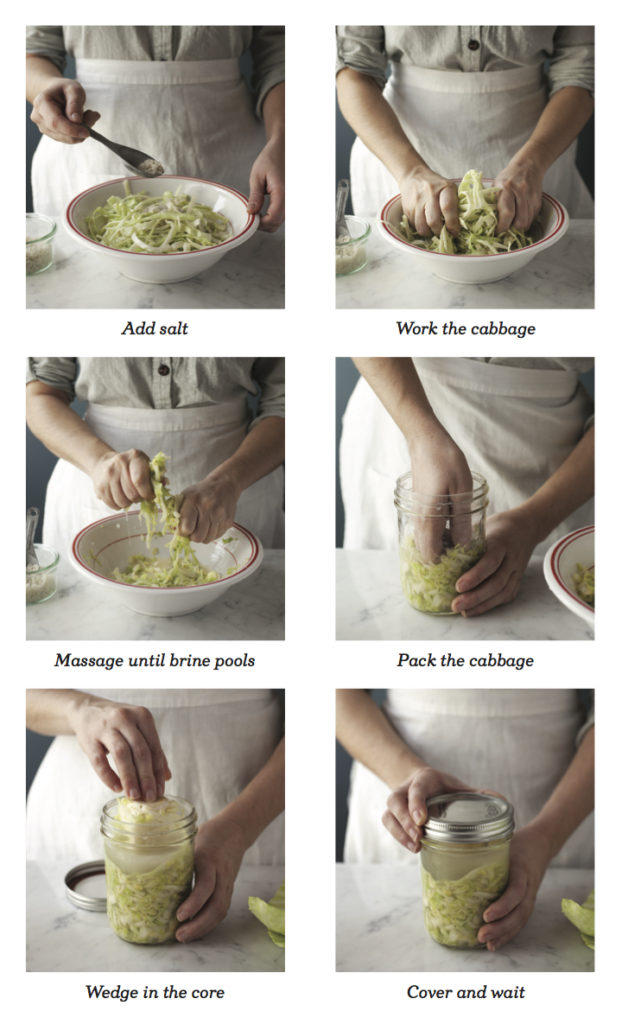Sauerkraut is sexy! And the benefits of fermented veggies are beyond outstanding.
What comes up for you when you think about saurkraut? Is it that cabbage stuff you put on a hot dog at a baseball game? Is it a strong-smelling garlicky dish that your grandmother or great-grandmother may have served?
There is literally a whole world of cultured and fermented foods and beverages such as kombucha, kimchee, kefir, kvass, miso, and more! And they are all great choices. For today we are looking at traditional sauerkraut, but all the benefits of other fermented foods are the same.
So what is so sexy about fermented veggies?
They’ll give you..
1) Glowing skin
2) A flatter tummy
3) Better digestion
4) More energy
5) A stronger immune system
Alright, Are you in?
What I’m talking about is old fashioned, lacto-fermented sauerkraut (pickled cabbage).
What in the world is lacto-fermented?
Lacto-fermented means the good bacteria that live on your veggies, in this case cabbage leaves, are kept alive and are cultured so that the “beneficial bacteria” – the lacto-baccilli – are working for you. Lacto-baccilli are the friendly bugs in your gut, making lactic acid, and making your tummy happy! They keep the bad bugs such as opportunistic bacteria, yeasts, and parasitic bacteria from taking over and making you sick.
The more of these probiotic (gut friendly bacteria) you have, the stronger your immune system – therefore less colds, less tissues, less missed days of work and more time to take “mental” health days.
How do the bacteria help?
These good bacteria are living organisms and just like you, they have to eat. When they eat the sugars from cabbage leaves or carrots for example, one of their by-products is lactic acid.
Lactic acid? Isn’t that bad?
Nope! This is the good kind of acid you want working for you in your stomach. Acid helps to lower the stomach pH and makes it a less hospitable environment for the bag buggies that can come in our food. Acid in your stomach activates digestive enzymes that help break down proteins. This means less gas and bloating. When you eat kraut, it actually alkalizes your blood. You want that! When you are alkaline, you get back to a strong immune system – less yeast infections, less inflammation, less breakouts. You get that “healthy glow.”
When is it good to eat kraut?
For maximum digestive power, consume kraut with your meals, especially foods that are high in protein. But, anytime you can get it in would be fantastic!
Where do I find lacto-fermented kraut?
Look for it in your health food store’s refrigerated section. Make sure it says either “lacto-fermented”, “raw”, or “unpasteurized.”
How can I be sure if a particular kraut is alive with the good bacteria?
If vinegar is listed as one of the ingredients or if it is unrefrigerated, though it may be very tasty and it will be preserved for a very long time, it ain’t the cabbage with the best bacteria bang for your buck.
Easy Sauerkraut Recipe:
Makes Roughly 4 Cups
Ingredients
1 large head of cabbage, any variety
1 tablespoon sea salt, more if needed
Directions
- Pull off and set aside outer leaves of the cabbage. Cut the cabbage into quarters. Remove and save the core. Chop each wedge into thin slices.
- Place sliced cabbage in a large mixing bowl and sprinkle it with salt. You can let the salted cabbage sit for 20 minutes and the salt will start to pull the water from the cabbage reducing the time you need to massage it.
- Vigorously massage (like they are tight shoulder muscles that need relaxing!) the cabbage and salt with your hands for 5–10 minutes until it becomes limp, moist, has shrunk to about half its original volume and you have a pool of liquid at the bottom of the bowl.
- Taste for salt. Take a piece from the bottom of the bowl. It should taste really salty, like you got a mouthful of ocean water. If it isn’t salty enough, add ½ teaspoon of salt, mix well and taste again. Too salty? Add 1-2 tablespoons of water, mix well and taste again.
- Tightly pack the massaged cabbage into the jars, tamping down with your fist (or a rock, or bottom of mason jar.) Add any extra liquid from the bowl into the jar. As you tamp down the cabbage, liquid (brine) should come up and cover the cabbage. Make sure the cabbage is completely covered in brine. Your goal here is to protect the compressed cabbage from exposure to air – bad bacteria need that oxygen from the air to grow
- Layer the top of the cabbage with the core and outer cabbage leaves and seal the jar (not too tight, finger tight)
- Set the jar out of direct sunlight, but somewhere you can have fun watching it ferment – your kitchen counter might be a good spot. Now it’s time for the bacteria to do their work.
- Watch the brine level. If it drops below the cabbage level, press the cabbage down.
- Let the cabbage ferment for 3–14 days at room temperature. If the lid is bulging, burp the jar to let some of the carbon dioxide escape. Check it daily for desired taste. Any layer of bubbles or foam can be skimmed off during fermentation or after it’s done. If you see mold, remove it immediately.
- Store in the refrigerator and enjoy!

Here’s to peaceful digestion!
P.S
My favorite local Seattle place for fermented items is Firefly Kitchens, check them out and support local business!

